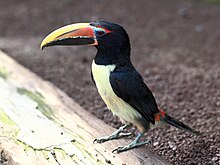Green arassari
| Green arassari | ||||||||||
|---|---|---|---|---|---|---|---|---|---|---|

Green macaw ( Pteroglossus viridis ), ♂ |
||||||||||
| Systematics | ||||||||||
|
||||||||||
| Scientific name | ||||||||||
| Pteroglossus viridis | ||||||||||
| ( Linnaeus , 1766) |
The Grünarassari ( Pteroglossus viridis ) is a toucan species from the genus of the Schwarzarassaris ( Pteroglossus ). The beak is conspicuously colored red, yellow and black. Due to the red rump , the small body size and the yellow underside of the body, the species can be easily distinguished from other black and green macaws . After the Red List of Threatened Species of IUCN is not in danger of Green Aracari ( least concern ).
No subspecies are distinguished.
features
The green rassari is the smallest species of the black rassari . He reaches a body length of about 32 to 34 centimeters and a weight of 120 to 162 grams. The tail accounts for 9.6 to 12.1 centimeters. The beak length in the male is between 7.3 and 9.8 centimeters. Females have slightly smaller beaks, measuring between 6.6 and 8.1 centimeters.
The green arassari is the only species of the genus that shows a conspicuous sexual dimorphism besides the written arassari . The beak is yellow, red and black. The top of the body is black-green, the underside yellow, the rump red. Males have a black head and neck, in females these areas are maroon. The upper beak is yellow from the ridge to the tip, the sides are red and separated from the yellow ridge line by a narrow black stripe. The lower bill is black and has a small orange-red triangle at the base.
Fledglings are similar to adult birds, but their plumage is duller and greener on the top of the body. The yellow underside of the body is partly covered with cinnamon, the beak is initially completely horn-colored.
distribution and habitat
The distribution area of the Grünarassaris is in northern South America . They are found in Brazil , French Guiana , Guyana , Suriname and Venezuela .
The green arassari inhabits moist evergreen forests in the lowlands and forests along rivers. It also colonizes secondary forest and occasionally occurs on plantations. Grünarassaris prefer to stay in tree tops.
food
The green arassari looks for food individually, in pairs and in small groups. The food spectrum includes the fruits of over 100 plants, including in particular the fruits of ant trees and the palm species Oenocarpus bacaba . It plays an important ecological role in its range as it is involved in the spread of seeds. Especially during the breeding season, green macaws also feed on insects.
Reproduction
The reproductive behavior has so far only been insufficiently investigated in the field. Most of the data come from captivity. The female lays two to four white eggs, the incubation period is 16 to 17 days, the nestling period is 42 to 47 days.
attitude
Green macaws are occasionally kept in zoological gardens. Between 1988 and 1996, a total of 100 young animals were raised in ten zoos. Some zoological gardens, including the Walsrode World Bird Park , have already been bred in the second generation. The species is now also occasionally offered in pet shops.
supporting documents
literature
- Werner Lantermann: Toucans and Arassaris. Filander Verlag, Fürth 2002, ISBN 3-930831-46-5
- Lester L. Short and Jennifer FM Horne: Toucans, Barbets and Honeyguides - Ramphastidae, Capitonidae and Indicatoridae . Oxford University Press, Oxford 2001, ISBN 0-19-854666-1
Web links
- National Finch and Softbill Society: Green Aracari ( Pteroglossus viridis ) (accessed May 7, 2010)
- Videos of Green Araçari ( Pteroglossus viridis ) at ibc.lynxeds.com (accessed May 13, 2010)
Individual evidence
- ↑ a b Pteroglossus viridis in the endangered Red List species the IUCN 2011. Posted by: BirdLife International, 2009. Accessed November 13, 2011 ..
- ↑ Short et al., P. 371
- ↑ Lantermann, p. 120
- ↑ Short et al., P. 371
- ↑ Thomas Tully: Avian medicine preview at books.google.de (English, accessed on May 7, 2010)
- ↑ Lantermann, p. 120
- ↑ Short et al., P. 372
- ↑ Short et al., P. 372
- ↑ Wolfgang Grummt (editor), Harro Strehlow (editor): Zoo animal husbandry: animals in human care. Birds preview at books.google.de (accessed on May 7, 2010)
- ^ Lantermann, p. 121 and p. 122

